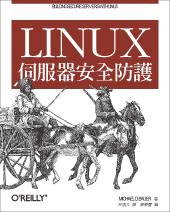The Secured Enterprise: Protecting Your Information Assets
暫譯: 安全企業:保護您的資訊資產
Paul E. Proctor, F. Christian Byrnes
- 出版商: Prentice Hall
- 出版日期: 2002-02-28
- 售價: $1,450
- 貴賓價: 9.5 折 $1,378
- 語言: 英文
- 頁數: 336
- 裝訂: Paperback
- ISBN: 013061906X
- ISBN-13: 9780130619068
已過版
買這商品的人也買了...
-
 3D Computer Graphics, 3/e (Hardcover)
3D Computer Graphics, 3/e (Hardcover)$2,780$2,641 -
 C++ Primer, 3/e 中文版
C++ Primer, 3/e 中文版$980$774 -
 Introduction to Algorithms, 2/e (Hardcover)
Introduction to Algorithms, 2/e (Hardcover)$990$970 -
 802.11 Wireless Networks: The Definitive Guide
802.11 Wireless Networks: The Definitive Guide$1,650$1,568 -
 Thinking in Java 中文版 (Thinking in Java, 2/e)
Thinking in Java 中文版 (Thinking in Java, 2/e)$920$727 -
 鳥哥的 Linux 私房菜
鳥哥的 Linux 私房菜$560$476 -
 JavaScript 範例活用辭典
JavaScript 範例活用辭典$450$351 -
 UML 設計實作寶典
UML 設計實作寶典$650$553 -
 Dreamweaver MX for JSP 夢幻咖啡香
Dreamweaver MX for JSP 夢幻咖啡香$620$527 -
 Red Hat Linux 9 實務應用
Red Hat Linux 9 實務應用$650$514 -
 802.11 無線網路技術通論 (802.11 Wireless Networks: The Definitive Guide)
802.11 無線網路技術通論 (802.11 Wireless Networks: The Definitive Guide)$760$600 -
 Borland 傳奇
Borland 傳奇$280$221 -
 Red Hat Linux 9 架站實務
Red Hat Linux 9 架站實務$620$490 -
 專業 JSP 程式設計 (Professional JSP, 2/e)
專業 JSP 程式設計 (Professional JSP, 2/e)$780$616 -
 STRUTS 實作手冊(Struts in Action: Building Web Applications with the Leading Java Framework)
STRUTS 實作手冊(Struts in Action: Building Web Applications with the Leading Java Framework)$690$538 -
 程式設計專家手冊 (The Practice of Programming)
程式設計專家手冊 (The Practice of Programming)$420$332 -
 深入淺出 JBuilder 程式設計實作(JBuilder 9.0/8.0/7.0 適用) (Charlie Calvert's Learn Jbuilder)
深入淺出 JBuilder 程式設計實作(JBuilder 9.0/8.0/7.0 適用) (Charlie Calvert's Learn Jbuilder)$720$562 -
 Practical Java Programming Language Guide 中文版 (Practical Java Programming Language Guide)
Practical Java Programming Language Guide 中文版 (Practical Java Programming Language Guide)$560$442 -
 Linux 伺服器安全防護 (Building Secure Servers with Linux)
Linux 伺服器安全防護 (Building Secure Servers with Linux)$580$458 -
 Effective Java Programming Language Guide 中文版 (Effective Java Programming Language Guide)
Effective Java Programming Language Guide 中文版 (Effective Java Programming Language Guide)$560$442 -
 管理資訊系統─管理數位化公司 (Management Information Systems: Managing the Digital Firm, 8/e)
管理資訊系統─管理數位化公司 (Management Information Systems: Managing the Digital Firm, 8/e)$800$760 -
 鳥哥的 Linux 私房菜-伺服器架設篇
鳥哥的 Linux 私房菜-伺服器架設篇$750$638 -
 Ant 實作手冊 (Java Development With Ant)
Ant 實作手冊 (Java Development With Ant)$690$538 -
 Hacking: The Art of Exploitation
Hacking: The Art of Exploitation$1,500$1,425 -
 $399Hacking Exposed Computer Forensics (Paperback)
$399Hacking Exposed Computer Forensics (Paperback)
相關主題
商品描述
Securing your key digital and information assets in an age of insecurity.
Securing enterprise data, applications, and intellectual property has become THE critical issue for business decision-makers in this era of hackers and potential cyberterrorism. But until now, most books on information security have been written for programmers and networking professionals, not business people. The Secured Enterprise: Protecting Your Information Assets fills the gap, delivering a non-technical, business-focused briefing on every key aspect of information security: frompeople to process to technology.
- A guide to today's security threats—including cyberterrorism
- How to establish effective, realistic security policies
- The tools for defending your information assets
- Effective mechanisms for identification, authentication, and access control
- What firewalls can—and cannot—do
- Vulnerability scanners, virus detectors, and intrusion detection systems
- Virtual private networks: leveraging the cost savings without exposing your data to risk
- Securing B2B and B2C e-commerce
- How to evaluate third-party security products and services
- New security options for wireless applications
Security has gotten more complex with time, and it has become more difficult to distill it. After reading this book you will understand security better and be more prepared to apply it in your enterprise.
—Jeff Moss,
Founder, DEF CON President,
Black Hat, Inc
Table of
Contents
Foreword.
Acknowledgments.
Introduction: How to Read This Book.
I. INTRODUCTION TO SECURITY.
1. Introduction to Security.
2. Threat Briefing.
3. Security
Policies.
4. Authentication, Authorization, Access Control.
II. SECURITY TECHNOLOGIES.
5. Firewalls.
6. Vulnerability Scanners.
7. Virus Detection and
Content Filters.
8. Intrusion Detection.
9. Public Key Infrastructure
and Encryption.
10. Encrypted Communications.
11. Mobile Workers and
Wireless LANs.
12. Single Signon.
13. Digital Signatures and Electronic
Commerce.
III. IMPLEMENTATION.
14. Establishing a Security Program.
15. Security Assessments.
16. Managed Security Services.
17. Response and Recovery.
18.
Implementing Web and Internet Security.
IV. ODDS AND ENDS.
19. Legal Issues.
20. Putting It All Together.
Glossary.
Index.
商品描述(中文翻譯)
在不安全的時代,保護您的關鍵數位和資訊資產。
保護企業數據、應用程式和智慧財產權已成為商業決策者在這個駭客和潛在網路恐怖主義的時代中的關鍵問題。但直到現在,大多數有關資訊安全的書籍都是為程式設計師和網路專業人士撰寫的,而非商業人士。《安全企業:保護您的資訊資產》填補了這一空白,提供了一個非技術性、以商業為重點的簡報,涵蓋資訊安全的每一個關鍵方面:從人員到流程再到技術。
- 當今安全威脅的指南——包括網路恐怖主義
- 如何建立有效且現實的安全政策
- 保護您的資訊資產的工具
- 身份識別、認證和存取控制的有效機制
- 防火牆能做什麼——以及不能做什麼
- 漏洞掃描器、病毒檢測器和入侵檢測系統
- 虛擬私人網路:在不暴露您的數據於風險的情況下利用成本節省
- 保護B2B和B2C電子商務
- 如何評估第三方安全產品和服務
- 無線應用的新安全選項
「隨著時間的推移,安全變得更加複雜,提煉它變得更加困難。閱讀這本書後,您將更好地理解安全,並更有準備在您的企業中應用它。」
—Jeff Moss,DEF CON創始人,Black Hat, Inc總裁
**目錄**
前言。
致謝。
導言:如何閱讀本書。
I. 安全介紹。
1. 安全介紹。
2. 威脅簡報。
3. 安全政策。
4. 認證、授權、存取控制。
II. 安全技術。
5. 防火牆。
6. 漏洞掃描器。
7. 病毒檢測和內容過濾器。
8. 入侵檢測。
9. 公開金鑰基礎設施和加密。
10. 加密通信。
11. 移動工作者和無線局域網。
12. 單一登入。
13. 數位簽名和電子商務。
III. 實施。
14. 建立安全計畫。
15. 安全評估。
16. 管理安全服務。
17. 回應與恢復。
18. 實施網路和互聯網安全。
IV. 雜項。
19. 法律問題。
20. 整合所有內容。
術語表。
索引。































